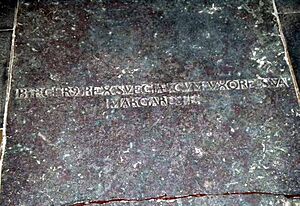Birger, King of Sweden facts for kids
Quick facts for kids Birger |
|
|---|---|

Birger's memorial portrait at St. Bendt's Church, Ringsted
|
|
| King of Sweden | |
| Reign | 18 December 1290 – March/April 1318 |
| Coronation | 2 December 1302, Söderköping |
| Predecessor | Magnus III |
| Successor | Magnus IV |
| Born | 1280 |
| Died | 31 May 1321 (aged 40–41) |
| Burial | Ringsted, Zealand |
| Spouse |
Martha of Denmark
(m. 1298) |
| House | Bjelbo |
| Father | Magnus III of Sweden |
| Mother | Helvig of Holstein |
Birger (Swedish: Birger Magnusson; 1280 – 31 May 1321) was the King of Sweden for many years, from 1290 to 1318. His time as king was quite difficult and filled with family conflicts. He was even captured by his own brothers, Erik and Valdemar, in an event called the "Håtuna games" in 1306. Later, when he tried to get back at them, it caused a big uprising. This led to Birger losing his crown and his 18-year-old son, Magnus, being executed.
Contents
Becoming King of Sweden
Birger was the son of King Magnus III of Sweden and Helvig of Holstein. He was named king of Sweden when he was only four years old. His father did this to make sure Birger would become king after him. King Magnus III had taken the throne from his own older brother, King Valdemar, in 1275.
Before King Magnus III died, he asked his relative, Torkel Knutsson, who was a very important leader, to look after young Birger. In 1302, Birger was officially crowned king in Söderköping. Around the same time, he married Martha of Denmark, who was the daughter of King Eric V of Denmark.
Early Years as King
Birger was only ten years old when his father passed away. At this time, Torkel Knutsson was the most powerful person in Sweden. He helped guide the country.
In 1293, Torkel Knutsson led the Swedish army to a victory in western Karelia. This journey is often called the Third Swedish Crusade. When Torkel Knutsson came back, a disagreement had started between King Birger and his two younger brothers, Erik and Valdemar. Torkel Knutsson supported King Birger in this family feud.
Conflicts with His Brothers
As Birger grew up, there were arguments within the Church of Sweden. His brothers, Erik Magnusson (Duke of Södermanland) and Valdemar Magnusson (Duke of Finland), used these problems to their advantage. Duke Erik wanted to create his own separate kingdom. This area included Bohuslän, which he got when he married a Norwegian princess, and Halland, located near the borders of Sweden, Norway, and Denmark.
A civil war began between the brothers. By 1306, things calmed down a bit. The dukes agreed that Birger's son, Magnus Birgersson, would be the next king. To show they wanted peace, Torkel Knutsson, who was Duke Valdemar's father-in-law, was executed in 1306.
Later that same year, in an event known as the Håtuna games, Birger was captured by his brothers. They took him prisoner at the royal estate of Håtuna in Uppland. He was then held at Nyköping Castle (Nyköpingshus).
Release and Continued Strife
In 1308, the Danish king forced Erik and Valdemar to release King Birger. However, they made him agree to very difficult terms. Once Birger was free, he asked Denmark for help, and the fighting started all over again.
Birger was still called king, but he had to give up much of his royal land. He only kept eastern Uppland, Närke, his brother Erik's old Duchy of Södermanland, Östergötland, Gotland, and the Castle of Viborg.
In 1312, Duke Erik married Ingeborg of Norway, the daughter of King Haakon V of Norway. This was part of a double wedding in Oslo. At the same time, Erik's brother Duke Valdemar married Ingeborg Eriksdottir of Norway, who was the daughter of King Eric II of Norway.
Duke Erik also controlled Bohuslän from Norway and northern Halland. He was still trying to create his own kingdom around the Göta älv river.
The Nyköping Banquet
In 1317, King Birger finally got his revenge. He captured his brothers during a famous event called the Nyköping Banquet (Nyköpings gästabud). According to an old story called Eric's Chronicle (Erikskrönikan), the dukes were starved to death in a cellar at Nyköping Castle.
Exile and End of Reign
Birger was removed from power by his brothers' supporters in 1318. He eventually went into exile in Denmark, seeking help from his brother-in-law, King Eric VI of Denmark. He even took the royal records with him.
His 18-year-old son, Magnus, arrived that year with Danish soldiers to try and save Birger. But an army led by Canute Porse defeated them at Söderköping. This battle pretty much ended the conflict.
Birger first escaped to Gotland, leaving Magnus to defend the important Stegeborg Castle. Magnus was captured there and later executed in Stockholm in 1320. Birger's younger son, Eric, had died the year before. King Birger himself died in Denmark the year after, in 1321.
In 1319, the three-year-old son of Duke Erik, who was also King Magnus VII of Norway, was named King of Sweden. His mother, Duchess Ingeborg, ruled for him for a short time.
Birger's Children
- Magnus Birgersson (1300–1320)
- Eric Birgersson
- Agnes Birgersdotter
- Katarina Birgersdotter
Modern Story
In 2003, a band called Falconer released an album titled The Sceptre of Deception. This album tells a story based on this period of Swedish history. It covers the events during King Birger's rule and the long struggles he had with his brothers and the kings of Denmark and Norway.


